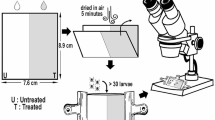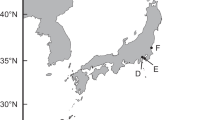Abstract
Caddisfly larvae (Limnophilus spp.) are important predators of eggs of the rough-skinned newt (Taricha granulosa). Newts may possess extremely large quantities of the neurotoxin tetrodotoxin (TTX) in their skin, and females may provision this toxin in their eggs. Using a competitive inhibition enzymatic immunoassay, we examined TTX-resistant caddisflies, sympatric with the known most toxic population of newts, for the presence of TTX. We found that caddisflies sequester TTX after consuming eggs in the laboratory. Caddisfly larvae that were frozen immediately after collecting in the wild possessed TTX. Finally, wild-caught larvae reared on a TTX-free diet in the laboratory retained TTX for up to 134 days, through metamorphosis and into the adult stage.



Similar content being viewed by others
References
Brodie, Jr., E. D. 1968. Investigations on the skin toxin of the adult rough-skinned newt, Taricha granulosa. Copeia 1968:307–313.
Brodie III, E. D. 2010. Patterns, process, and the parable of the coffeepot incident: Arms races between newts and snakes from landscapes to molecules, pp. 93–120, in J. B. Losos (ed.), In the light of evolution: Essays from the laboratory and field. Roberts and Co., Greenwood Village.
Brodie III, E. D., Feldman, C. R., Hanifin, C. T., Motychak, J. E., Mulcahy, D. G., Williams, B. L., and Brodie, Jr., E. D. 2005. Parallel arms races between garter snakes and newts involving tetrodotoxin as the phenotypic interface of coevolution. J. Chem. Ecol. 31:343–356.
Corbet, P. S. 1999. Dragonflies: Behaviour and ecology of Odonata. Cornell University Press, Ithaca.
Duffey, S. S. 1980. Sequestration of plant natural products by insects. Annu. Rev. Entomol. 25:447–477.
Eisner, T., Eisner, M., Rossini, C., Iyengar, V. K., Roach, B. L., Benedikt, E., and Meinwald, J. 2000. Chemical defense against predation in an insect egg. Proc. Natl. Acad. Sci. USA 97:1634–1639.
Feldman, C. R., Brodie, Jr., E. D., Brodie III, E. D., and Pfrender, M. E. 2009. The evolutionary origins of beneficial alleles during the repeated adaptation of garter snakes to deadly prey. Proc. Natl. Acad. Sci. USA 106:13415–13420.
Feldman, C. R., Brodie, Jr., E. D., Brodie III, E. D., and Pfrender, M. E. 2010. Genetic architecture of a feeding adaptation: garter snake (Thamnophis) resistance to tetrodotoxin bearing prey. Proc. Roy. Soc. B 277:3317–3325.
Gall, B. G., Brodie III, E. D., and Brodie, Jr., E. D. 2011a. Survival and growth of the caddisfly Limnephilus flavastellus after predation on toxic eggs of the Rough-skinned Newt (Taricha granulosa). Can. J. Zool. 89:483–489.
Gall, B. G., Stokes, A. N., French, S. S., Schlepphorst, E. A., Brodie III, E. D., and Brodie, Jr., E. D. 2011b. Tetrodotoxin levels in larval and metamorphosed newts (Taricha granulosa) and palatability to predatory dragonflies. Toxicon 57:978–983.
Gall, B. G., Stokes, A. N., French, S. S., Brodie III, E. D., and Brodie, Jr., E. D. 2012a. Female newts (Taricha granulosa) produce tetrodotoxin laden eggs after long term captivity. Toxicon 60:1057–1062.
Gall, B. G., Brodie, E. D., III, and Brodie, E. D., Jr. 2012b. Fine-scale selection by ovipositing females increases egg survival. Ecol. Evol. In press.
Geffeney, S., Brodie, Jr., E. D., Ruben, P. C., and Brodie III, E. D. 2002. Mechanisms of adaptation in a predator-prey arms race: TTX-resistant sodium channels. Science 297:1336–1339.
Geffeney, S. L., Fujimoto, E., Brodie III, E. D., Brodie, Jr., E. D., and Ruben, P. C. 2005. Evolutionary diversification of TTX-resistant sodium channels in a predator-prey interaction. Nature 434:759–763.
Hanifin, C. T., Yotsu-Yamashita, M., Yasumoto, T., Brodie III, E. D., and Brodie, Jr., E. D. 1999. Toxicity of dangerous prey: Variation of tetrodotoxin levels within and among populations of the newt Taricha granulosa. J. Chem. Ecol. 25:2161–2175.
Hanifin, C. T., Brodie III, E. D., and Brodie, Jr., E. D. 2002. Tetrodotoxin levels of the rough-skin newt, Taricha granulosa, increase in long-term captivity. Toxicon 40:1149–1153.
Hanifin, C. T., Brodie III, E. D., and Brodie, Jr., E. D. 2003. Tetrodotoxin levels in eggs of the rough-skin newt, Taricha granulosa, are correlated with female toxicity. J. Chem. Ecol. 29:1729–1739.
Hanifin, C. T., Brodie, Jr., E. D., and Brodie III, E. D. 2008. Phenotypic mismatches reveal escape from arms-race coevolution. Plos Biol. 6:471–482.
Hutchinson, D. A., Mori, A., Savitzky, A. H., Burghardt, G. M., Wu, X. G., Meinwald, J., and Schroeder, F. C. 2007. Dietary sequestration of defensive steroids in nuchal glands of the Asian snake Rhabdophis tigrinus. Proc. Natl. Acad. Sci. USA 104:2265–2270.
Kao, C. Y. 1966. Tetrodotoxin, saxitoxin, and their significance in the study of excitation phenomena. Pharmacol. Rev. 18:997–1049.
Kodama, M., Noguchi, T., Maruyama, J., Ogata, T., and Hashimoto, K. 1983. Release of tetrodotoxin and paralytic shellfish poison from puffer liver by RNase. J. Biochem. 93:243–247.
Kono, M., Matsui, T., Furukawa, K., Yotsu-Yamashita, M., and Yamamori, K. 2008. Accumulation of tetrodotoxin and 4,9-anhydrotetrodotoxin in cultured juvenile kusafugu Fugu niphobles by dietary administration of natural toxic komonfugu Fugu poecilonotus liver. Toxicon 51:1269–1273.
Lin, S.-J. and Hwang, D.-F. 2001. Possible source of tetrodotoxin in the starfish Astropecten scoparius. Toxicon 39:573–579.
Matsui, T., Yamamori, K., Furukawa, K., and Kono, M. 2000. Purification and some properties of a tetrodotoxin binding protein from the blood plasma of kusafugu, Takifugu niphobles. Toxicon 38:463–468.
Matsumoto, T., Nagashima, Y., Kusuhara, H., Sugiyama, Y., Ishizaki, S., Shimakura, K., and Shiomi, K. 2007. Involvement of carrier-mediated transport system in uptake of tetrodotoxin into liver tissue slices of puffer fish Takifugu rubripes. Toxicon 50:173–179.
Mosher, H. S., Fuhrman, F. A., Buchwald, H. D., and Fischer, H. G. 1964. Tarichatoxin-tetrodotoxin: A potent neurotoxin. Science 144:1100–1110.
Nagashima, Y., Yamamoto, K., Shimakura, K., and Shiomi, K. 2002. A tetrodotoxin-binding protein in the hemolymph of shore crab Hemigrapsus sanguineus: Purification and properties. Toxicon 40:753–760.
Lehman, E. M. 2006. Egg toxicity and egg predation in Rough-skinned Newts, Taricha granulosa. Ph.D. dissertation. Indiana University.
Narahashi, T., Moore, J. W., and Poston, R. N. 1967. Tetrodotoxin derivatives: Chemical structure and blockage of nerve membrane conductance. Science 156:976–979.
Nishida, R. 2002. Sequestration of defensive substances from plants by Lepidoptera. Annu. Rev. Entomol. 47:57–92.
Nussbaum, R. A., Brodie, Jr., E. D., and Storm, R. M. 1983. Amphibians and reptiles of the Pacific Northwest. University of Idaho Press, Moscow.
Petranka, J. 1998. Salamanders of the United States and Canada. Smithsonian Institution Press, Washington.
Stokes, A. N., Williams, B. L., and French, S. S. 2012. An improved competitive inhibition enzymatic immunoassay method for tetrodotoxin quantification. Biol. Proc. Online 14:1–5.
Wakely, J. F., Fuhrman, G. J., Fuhrman, F. A., Fischer, H. G., and Mosher, H. S. 1966. The occurrence of tetrodotoxin (tarichatoxin) in amphibia and the distribution of the toxin in the organs of newts (Taricha). Toxicon 3:195–203.
Wells, K. D. 2007. The ecology and behavior of Amphibians. University of Chicago Press, Chicago.
Wiggins, G. B. 2004. pp. 28–32, Caddisflies: The underwater architects. Univ. Toronto Press Inc, Toronto.
Williams, B. L., Brodie, Jr., E. D., and Brodie III, E. D. 2004. A resistant predator and its toxic prey: Persistence of newt toxin leads to poisonous (not venomous) snakes. J. Chem. Ecol. 30:1901–1919.
Williams, B. L., Hanifin, C. T., Brodie III, E. D., and Brodie, Jr., E. D. 2010. Tetrodotoxin affects survival probability of rough-skinned newts (Taricha granulosa) faced with TTX-resistant garter snake predators (Thamnophis sirtalis). Chemoecology 20:285–290.
Williams, B. L., Lovenburg, V., Huffard, C. L., and Caldwell, R. L. 2011a. Chemical defense in pelagic octopus paralarvae: Tetrodotoxin alone does not protect individual paralarvae of the greater blue-ringed octopus (Hapalochlaena lunulata) from common reef predators. Chemoecology 21:131–141.
Williams, B. L., Hanifin, C. T., Brodie, Jr., E. D., and Brodie III, E. D. 2011b. Predators usurp prey defenses? Toxicokinetics of tetrodotoxin in common garter snakes after consumption of rough-skinned newts. Chemoecology. doi:10.1007/s00049-011-0093-3.
Yasumoto, T. and Yotsu-Yamashita, M. 1996. Chemical and etiological studies on tetrodotoxin and its analogs. Toxin Rev. 15:81–90.
Yotsu-Yamashita, M., Sugimoto, A., Terakawa, T., Shoji, Y., Miyazawa, T., and Yasumoto, T. 2001. Purification, characterization, and cDNA cloning of a novel soluble saxitoxin and tetrodotoxin binding protein from plasma of the puffer fish, Fugu pardalis. Eur. J. Biochem. 268:5937–5946.
Acknowledgments
We thank Joe Beatty for helping gain access to our research site, and Oregon State University for permitting us to use their facilities. This research was supported by the Utah State University Department of Biology and conducted in accordance with Utah State University Institutional Animal Care and Use Committee protocol (#1008R). Newts were collected under Oregon Department of Fish and Wildlife permit #004-11.
Author information
Authors and Affiliations
Corresponding author
Rights and permissions
About this article
Cite this article
Gall, B.G., Stokes, A.N., French, S.S. et al. Predatory Caddisfly Larvae Sequester Tetrodotoxin from Their Prey, Eggs of the Rough-Skinned Newt (Taricha granulosa). J Chem Ecol 38, 1351–1357 (2012). https://doi.org/10.1007/s10886-012-0213-8
Received:
Revised:
Accepted:
Published:
Issue Date:
DOI: https://doi.org/10.1007/s10886-012-0213-8




